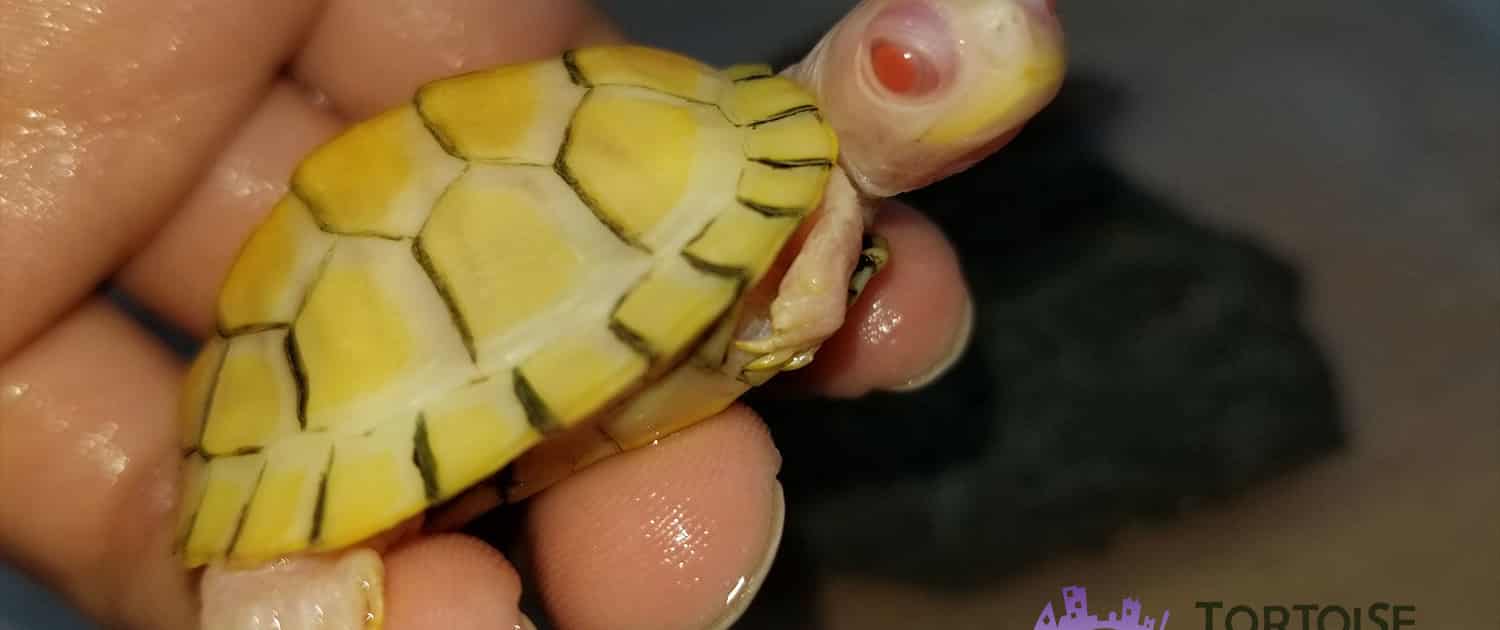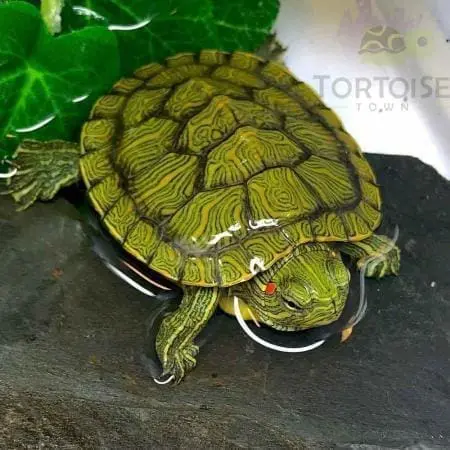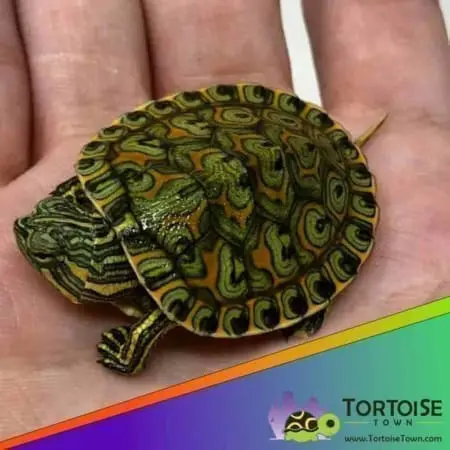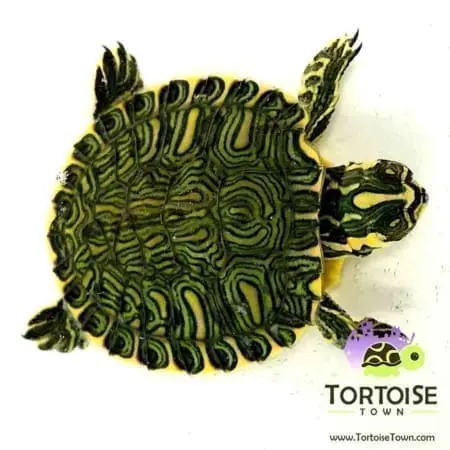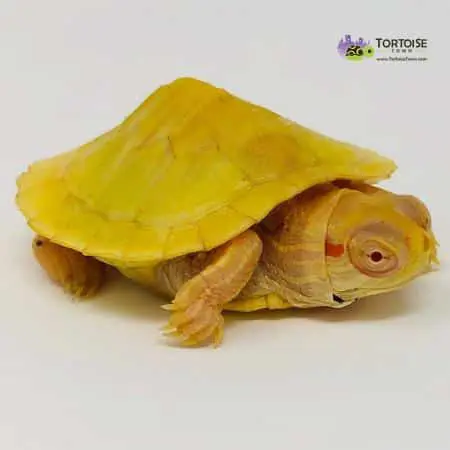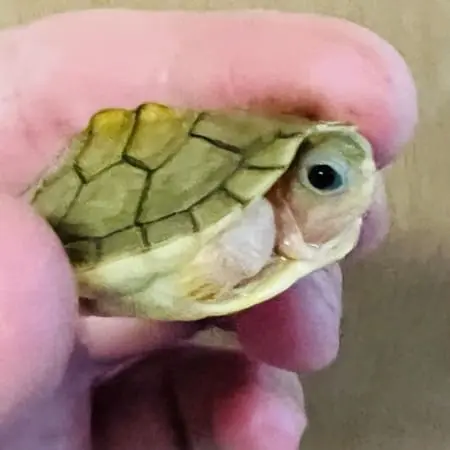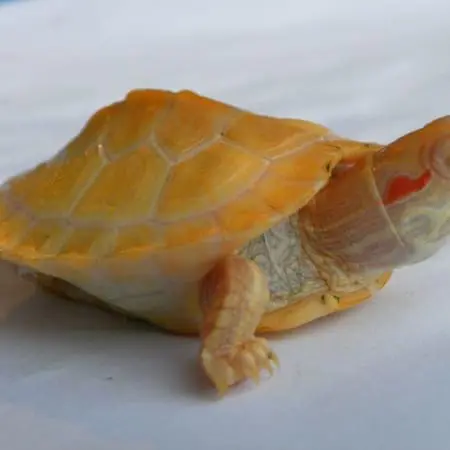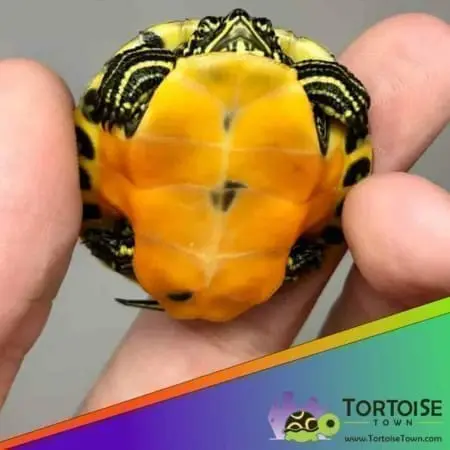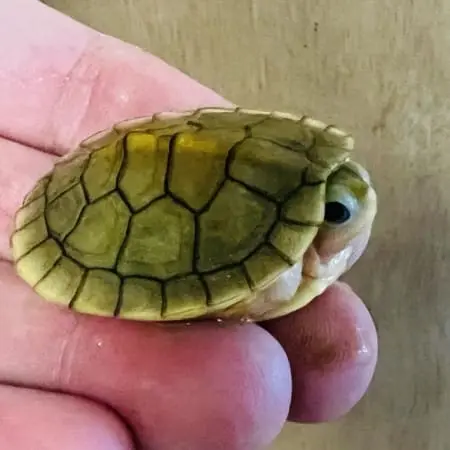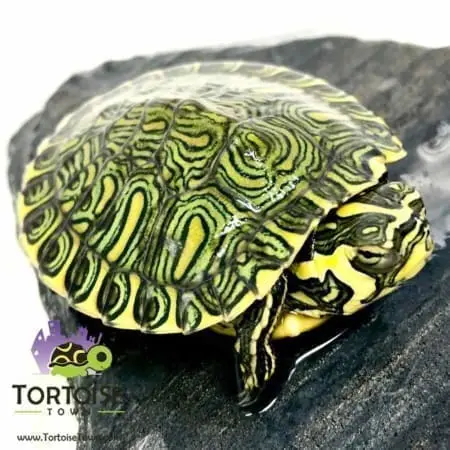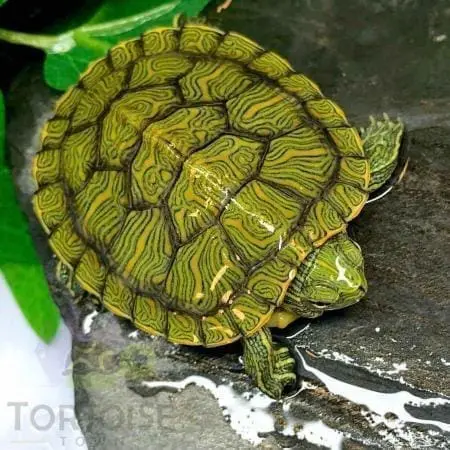Slider turtle care guide
Tortoise town provides the below slider turtle care guide in order to help you build the perfect habitat for your new baby slider turtle! Our biologist has listed each section of care below with valuable information regarding everything from the habitat parameters to diet.
Red Eared Slider Turtle Care
Housing
Red-eared Sliders for sale will need housing that mimics their natural environment – warm, with water for swimming, and a dry warm area in which to bask. A baby slider turtle for sale will need much less space and adult red eared slider turtles for sale. The same can be said for albino slider turtle and the yellow belly slider turtle for sale.
A glass or acrylic aquarium will be needed to house the Red-eared Slider; glass is usually better, since acrylic tends to be scratched easily. Another option is a plastic utility tub, wading pool, or stock tank.
Remember that your turtle will grow, and have larger housing requirements (see table below). An adult Red-eared Slider will eventually require at least a 55-gallon aquarium.
NOTE: To avoid having to buy many housing systems over the life of your turtle, you may wish to start out with a larger aquarium. Bigger is always better.
| Dimension | Formula for Minimum Size of Water Area* |
Example: 4-inch Turtle |
Example: 12-inch Turtle |
|---|---|---|---|
| Length | 4xL | 16 | 48 |
| Width | 2xL | 8 | 24 |
| Depth | 1.5xL | 6 | 18 |
| Typical Aquarium Size (gal) | 20 High | 120 | |
| L = Length of carapace (shell)* This is the minimum size of the area which will contain water, and does not include areas of dry land or air space above the water level to prevent the turtle from escaping. | |||
Slider turtle habitat
Cage furnishings: The cage will need to include a way for the turtle to easily exit the water and basking sites totally out of the water.
Substrate such as large, smooth, aquarium gravel can be used to form a slope to an area of dry land. Cork bark, driftwood, a piece of plexi-glass glued to the side of the aquarium, or a stable platform of smooth rocks may be used for a basking site.
A tight-fitting screen cover should be placed over the aquarium to prevent the turtle from escaping and objects falling into the aquarium. It is usually best to avoid plastic plants, as the turtle may attempt to eat them.
Slider turtle temperature
Heat: The air temperature in the area of the aquarium should be approximately 75°F. If the area will be colder than that, an infrared bulb or room heater may be used to maintain the proper temperature.
A basking site should be provided. An incandescent light bulb (75 watt or lower is generally sufficient) with a reflector should be placed over one area of the cage which has an elevated area that can serve as a basking platform.
The temperature of the basking site should be 85-90°F nearest the bulb. Any bulbs should be fixed solidly to something outside of the aquarium, above the screened top. Make absolutely sure the light cannot fall into the water or that the turtle can come into direct contact with the bulb.
Slider Turtle UVB Lighting
Light: If possible, provide exposure to direct sunlight, but guarantee the temperature within the cage will not become too high. NEVER place a glass or acrylic aquarium in direct sun, as it may become too warm.
If the outside temperature is within the turtle’s comfort zone, it could be placed in an outside tub. Be sure it can not escape and that it is safe from small children, pets and predators.
Full spectrum ultraviolet (UVA and UVB) fluorescent lighting should be used to enhance the turtle’s production of Vitamin D-3, and provide it with a more natural habitat. Bulbs must be replaced after 6 months, as their ability to emit true full-spectrum light diminishes over time.
The light source should be within 18-24 inches of the turtle. The light should shine directly on the turtle, and not be filtered through glass or plastic. It should be on a timer so the turtle has a normal day-night cycle.
Slider turtle water temperature
Red-eared Sliders need a water temperature of 75-86°F. Remember, they are cold-blooded animals and their metabolism will slow and they will become inactive if the temperature is too cold. This can also have an adverse effect on their digestive systems and result in severe health problems.
Water temperature can be maintained through the use of a submersible aquarium heater, which is on a thermostat. In general, estimate that you will need 5 watts per gallon of water. Be sure the thermometer is below the water line, and turn it off when removing water from the aquarium.
Follow the manufacturer’s directions to prevent the risk of electrocution. An accurate thermometer should be immersed in the water so the temperature can be monitored daily.
Red eared slider turtle water quality
Water quality is critical to the health of the turtle. Because uneaten food items, urine, and feces can contaminate the water, it becomes a very suitable place for bacteria and other organisms to grow. This is unhealthy for your turtle, and not very aesthetic for you, since the aquarium will smell.
The aquarium will need to be cleaned, and the water removed and replaced on a regular basis. Be sure, when changing the water, to have it at the right temperature before placing your turtle back in the aquarium. In addition, a dechlorinating agent should be used to treat the water prior to adding it to the aquarium.
How often the water needs to be changed depends, to a large part, on whether the turtle is fed in the aquarium or moved to a separate feeding tank, and if there is a filtration system in the tank. If moved for feeding, the water will generally need changing weekly.
To accomplish this, a siphon is used to remove a portion, usually 25-50%, of the water. The siphon can be used like a vacuum cleaner, to remove debris from the bottom while it is siphoning water.
Every 1-2 months, depending upon the conditions, the entire aquarium should be drained, cleaned, and refilled. Never start a siphon with your mouth.
Other Slider turtle information:
- Slider turtle care sheet
- red eared slider turtle
- peacock slider turtle
- caramel slider turtle
- albino Slider turtle for sale
- lemon lime slider turtle
- baby slider turtles
Slider turtle tank filter
There are a variety of aquarium filters which can be used to remove some of the debris and chemical buildup from the water in the aquarium.
Depending upon the design and size of your aquarium and turtle, an external canister, internal canister, or an under gravel filter are most commonly used. External filters allow more room for your turtle inside the aquarium.
As with the size of aquarium, the bigger the better; never skimp. The use of an air stone may help to move water and improve filtration.
Adding aquatic plants can assist in removing wastes from the water, but also may be eaten by the turtle, and thus produce more waste. You may have to experiment with your own turtle, to see if plants aid or hinder the maintenance of water quality.
Heaters, lighting, and filters should be plugged into a ground-fault interrupter, which will reduce the risk of electrocution if the equipment malfunctions, or if it is nonsubmersible and becomes wet.
To avoid the possibility of water running down the power cord into the receptacle, either have the interrupter higher than the aquarium, or form a drip loop so that part of the cord is below the receptacle on the interrupter.
Slider turtle Diet
Juveniles are mainly carnivorous, and become more omnivorous as they reach adulthood. The diet should be balanced and include a variety of meat-based protein sources and fresh plant material. Do not rely simply on commercial diets. Juveniles should be fed daily, whereas, adults can be fed every other day.
Turtles are messy eaters so it is best to move the turtle to a separate feeding tank. This may also help reduce the amount the turtle defecates in the water of his cage. Allow the turtle to eat for 15 minutes before moving it back to the aquarium.
With the right set-up, red-eared sliders can be pretty easy to take care of. First, you need a tank. Compared to other aquarium creatures, red-eared sliders require a relatively large amount of space. They also need clean water, so expect to change their water and clean their filters roughly once a week.
Red Ear Sliders are the most common aquatic turtle pet and can live for up to 50 years in captivity. Red Ear Sliders are very active and love to swim. While they are mostly aquatic, these diurnal turtles also enjoy a dry, warm place where they can climb out and bask under a heat light.
Keeping your water clean
A great habitat would be a large aquarium. A filter is recommended to help keep the water clean, and you will want to include an assortment of rocks, ramps, docks or other turtle accessories to provide ample space for climbing.
A garden or outdoor pond is another common habitat solution for Red Ear Sliders. Turtles are social animals and can be kept together as long as you provide enough space in their habitat.
When choosing any red ear slider turtle for sale or any turtle for sale it is important that you purchase a healthy animal from an experienced turtle breeder. Captive bred red eared slider turtles for sale should always be purchased over a wild caught adults when possible.
With a biologist ON SITE, our red ear slider turtle for sale are top notch and ready to ship to you via FedEx Overnight in heated or cooled, insulated shipping boxes and come with our live arrival and full 7 day health guarantee. One shipping charge covers up to 4 turtles or tortoises.
Remember when searching for any baby turtles for sale, and adult turtles for sale of any turtle store anywhere. If you are interested in tortoise care, please visit our care section.

